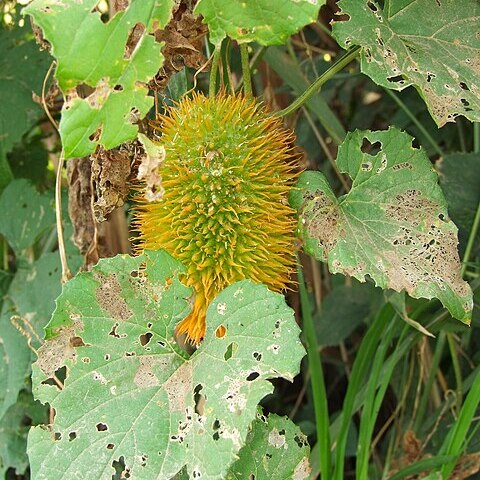Perennial herb. Stems prostrate or scandent to 7 m, almost glabrous to densely shortly crispate-pubescent, especially at nodes, flecked with darker green, becoming woody with pallid bark when old, arising from perennial tuberous rootstock; all parts foetid. Leaf-lamina 1·3-19·1 x 1·3-18·1 cm, ovate or ovate-triangular to very broadly ovate in outline, broadly and deeply cordate and narrowly decurrent on to petiole, almost plane and minutely denticulate to very strongly sinuate-denticulate, unlobed, acutely-acuminate, apiculate, punctate and almost glabrous to densely shortly crispate-pubescent on veins beneath, shortly scabrid-setulose or punctate above. Petiole 1·3-17 cm long, green-flecked like the stems. Tendrils simple or 2-fid. Flowers dioecious. Male flowers 1-8 (opening singly) in bracteate, pedunculate, subumbelliform inflorescences; peduncle 2-23 cm long; bract 3-30 mm long, oblanceolate to broadly rounded, closely subtending the flower, often cucullate; pedicels 0·2-7 cm long. Receptacle-tube 3-8 mm long, lobes 5-10 mm long, ovate or ovate-oblong, obtuse or rounded, dark green to black, bearing a number of stiff emergences on the back. Petals 1·7-3·5 cm long, pale yellow to orange, deeper orange to black at the base, obovate, rounded. Female flowers solitary; peduncle 0·2-6·5 cm long; bract 3-20 mm long; pedicel 0·2-18·6 cm long; ovary 8-26 x 3-11 mm, ellipsoid-rostrate, densely and softly muricate; receptacle-tube 2-2·5 mm long, lobes 2-11 mm long, ovate or triangular to oblong-lanceolate, acute to obtuse or rounded; petals 1·5-3·7 cm long. Fruit 3·5-7·5 x 2·5-5 cm, ovoid or ellipsoid, softly spiny, bright orange, dehiscent into 3 valves; fruit-stalk 5-10(20) cm long. Seeds 7·2-12 x 5-7·5 x 2-4·5 mm, enveloped in bright red pulp, ovate-oblong or elliptic-oblong in outline, compressed; faces flattened, slightly warted; margin grooved.
Dioecious, perennial herb, foetid, rootstock tuberous. Stems ± glabrous to pubescent, green-flecked, prostrate or climbing, up to 5 m long. Leaves green-flecked, up to 190 x 180 mm, decurrent on petiole; petioles up to 170 mm long. Tendrils simple or bifid. Male flowers subumbellate, 1-8; peduncle 20-230 mm long; bract 3-30 mm long, ± oblanceolate, subtending flower; pedicels 2-70 mm long; receptacle tube 1-8 mm long; lobes 5-10 mm long, ± ovate, dark green to black; petals obovate, 17-35 mm long, yellow to orange, deeper orange to black at base. Female flowers solitary; peduncle 65 mm long; bract 3-20 mm long; pedicel up to 185 mm long; receptacle tube 2.0-2.5 mm long; lobes 2-11 mm long, ± triangular; petals 15-37 mm long. Flowering time Dec.-Mar. Fruit ellipsoid, up to 75 x 50 mm, softly spiny, orange, dehiscent into 3 valves; stalk 50-200 mm long. Seeds ± oblong, flattened, 7-12 mm long, ± warted, margins grooved, in red pulp.
male flowers 1–8 (opening singly) in bracteate, pedunculate, subumbelliform inflorescences; peduncle 2–23 cm. long; bract 3–30 mm. long, oblanceolate to broadly rounded, closely subtending the flower, often cucullate; pedicels 0·2–7 cm. long. Receptacle-tube 3–8 mm. long, lobes 5–10 mm. long, ovate or ovate-oblong, obtuse or rounded, dark green to black, bearing a number of stiff emergences on the back. Petals 1·7–3·5 cm. long, pale yellow to orange, deeper orange to black at the base, obovate, rounded.
Prostrate or scandent herb. Tendrils simple or bifid. Stems and petioles spotted with numerous small darker green marks. Leaf lamina ovate or ovate-triangular in outline, broadly and deeply cordate, minutely denticulate to very strongly sinuate-denticulate, unlobed. Male flowers 1-8 (opening singly) in pedunculate subumbel-liform inflorescences. Fruit 35-75 x 25-50 mm, ovoid to ellipsoid, softly spiny. Flowers pale yellow to orange, deeper orange to black at base.
A herb. It is a pumpkin family plant. It is a creeper. It has a stout root. It can re-grow from this root. The vine can climb 7 m high. The leaves have a bad smell when crushed. The male flowers are in groups and female flowers occur singly on long stalks. The flowers are pale yellow. The fruit are 8 cm long. They turn yellow or orange when ripe. They are covered with soft prickles. They burst open exposing the seeds. The pulp is red.
Leaf-lamina 1·3–19·1 × 1·3–18·1 cm., ovate or ovate-triangular to very broadly ovate in outline, broadly and deeply cordate and narrowly decurrent on to petiole, almost plane and minutely denticulate to very strongly sinuate-denticulate, unlobed, acutely-acuminate, apiculate, punctate and almost glabrous to densely shortly crispate-pubescent on veins beneath, shortly scabrid-setulose or punctate above.
Female flowers solitary; peduncle 0·2–6·5 cm. long; bract 3–20 mm. long; pedicel 0·2–18·6 cm. long; ovary 8–26 × 3–11 mm., ellipsoid-rostrate, densely and softly muricate; receptacle-tube 2–2·5 mm. long, lobes 2–11 mm. long, ovate or triangular to oblong-lanceolate, acute to obtuse or rounded; petals 1·5–3·7 cm. long.
Stems prostrate or scandent to 7 m., almost glabrous to densely shortly crispate-pubescent, especially at nodes, flecked with darker green, becoming woody with pallid bark when old, arising from perennial tuberous rootstock; all parts foetid.
Seeds 7·2–12 × 5–7·5 × 2–4·5 mm., enveloped in bright red pulp, ovate-oblong or elliptic-oblong in outline, compressed; faces flattened, slightly warted; margin grooved.
Fruit 3·5–7·5 × 2·5–5 cm., ovoid or ellipsoid, softly spiny, bright orange, dehiscent into 3 valves; fruit-stalk 5–10(20) cm. long.
Petiole 1·3–17 cm. long, green-flecked like the stems.
Tendrils simple or 2-fid.
Flowers dioecious.

